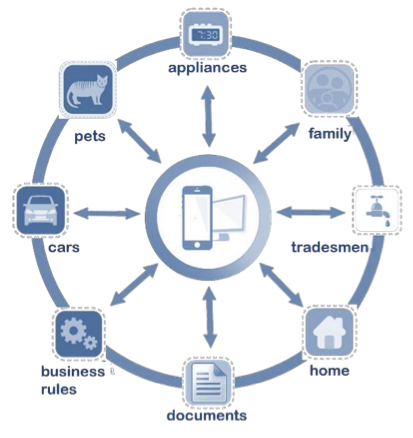 How would this work in practice? Mobile and tablet applications are limited only by vision and imagination, and space in this article permits only a brief summary. There are two principal post-sales areas where advantage can be gained, namely policy changes/inquiries and claims reporting/progress.
Imagine your home and contents policyholder receiving a renewal notice and reviewing the cover. This might show that the sums assured need revision and that a newly acquired item of jewelry should be added; perhaps an optional extra such as legal expenses cover is to be considered. By means of an appropriate mobile phone or tablet, the policyholder “logs in” and views current policy details. No doubt this will include a reminder that renewal is almost due.
Using the form of graphic display the policyholder is used to (sliders and check boxes on smart phones for example) the cost of changes are modeled. More information about the legal expenses cover is requested, received and possibly some questions answered. Mid-term changes are frequent, too, so any relevant date and details of change may subsequently be selected once the policy records are accessed from the mobile. When the customer is satisfied with the modeled changes, the new risk profile is sent to the insurer and a new premium generated. If accepted (or remodeled), payment details are collected, and no doubt certain questions required by the insurer are “check-boxed,” instant confirmation is given and promptly afterward updated documents e-mailed to the policyholder.
All of these events take place at a time, day and location of the customer’s choice. Unless the customer chooses otherwise, no call center conversation is required; no staff are needed to manually process the changes. In this example, all the requested changes were within the insurer’s underwriting and rating rules; had they not been, then an appropriate message would be generated ensuring, that a call center contact is focused upon more specialized and justified issues, requiring a smaller number of trained and empowered people. In effect, the call center becomes a skill center, a quite different entity.
Reporting claims and dealing with claims progress issues can easily be imagined, and again the limit is process appetite and creativity. Mobile technology has the advantage of a camera, GPS and verifiable date and time. So this data can be assured and becomes invaluable within the claims oversight process.
Photographs can be taken, with assured dates/times/locations of loss-related events, damage, articles etc. These can be attached to a mobile claims notification, with appropriate inbuilt guidance, and sent to the claims department to initiate the process. The mobile can be used to receive calls, texts and e-mails. Even voice messages or videos from the customer can be attached. Adjusters can be appointed automatically subject to a “rules engine”; replacement goods can be selected and offered via the mobile connection; estimates and invoices can be generated or photographed for sending on to the claims department.
The effect of these customer processes upon service delivery is abundantly clear. But what of the opportunity to save costs? In my experience, between 25% and 50% of inbound customer calls are of a standard, non-exceptional nature. Conservatively, once fully operational, I would expect mobile technology for post-sales activities to drive out 30% of staff and call center costs of the enterprise. For those who also use call center or technical staff to actually manually process changes, as well, similar levels of savings could be achieved in that part of the operation.
At this stage it is reasonable to ask, if the technology is available now, the advantages so attractive and already being employed by other enterprises, why have insurers, generally, not yet filled this space?
I speculate that there are five reasons:
- The skills required to build mobile technology platforms are not generally available in most insurers' computer departments.
Mobile process development is new and different, and simply importing legacy or internet systems on mobiles produces ugly, cumbersome customer applications. The solution is the careful selection of a third-party provider, working with staff, to introduce these new skills into the computer department.
- Core processes and enterprise data is jealously guarded by departments. Security is also of paramount importance.
They are right to be careful! These assets must not be put in harm’s way. Until complete confidence is established, the safe solution is to use replicated rules engines and validate changed data outside the core processes. The use of the latest and most secure encryption technology is paramount.
- Most IT departments have a tremendous backlog of legacy system updates. It’s essential but difficult to focus on a new mobile future when you are trapped in the technology of the past developments.
By using a third-party provider to quickly develop applications and train existing staff, an enterprise can begin to move forward and avoid being left behind by newer competitors.
- Development is seen as possibly expensive and probably protracted.
In fact, the opposite is true. It is surprisingly quick and relatively inexpensive to develop the latest generation of applications for mobile platforms compared with legacy systems. Payback can often be achieved within months of launch.
- There may be a lack of imagination or strategic understanding of what mobile applications can achieve.
It is, in my opinion, dismally true that some of the few mobile insurance “apps” available download little more than contact details, or a claim form. Recreating on a mobile what an enterprise already does on the Internet misses the point entirely and wastes a unique opportunity.
In conclusion, mobile technology has rendered the call center, in its current form, obsolete. The only question is how long the process will take. It will be fascinating to see the more agile and visionary insurance enterprises seize the opportunities presented by mobile technology.
How would this work in practice? Mobile and tablet applications are limited only by vision and imagination, and space in this article permits only a brief summary. There are two principal post-sales areas where advantage can be gained, namely policy changes/inquiries and claims reporting/progress.
Imagine your home and contents policyholder receiving a renewal notice and reviewing the cover. This might show that the sums assured need revision and that a newly acquired item of jewelry should be added; perhaps an optional extra such as legal expenses cover is to be considered. By means of an appropriate mobile phone or tablet, the policyholder “logs in” and views current policy details. No doubt this will include a reminder that renewal is almost due.
Using the form of graphic display the policyholder is used to (sliders and check boxes on smart phones for example) the cost of changes are modeled. More information about the legal expenses cover is requested, received and possibly some questions answered. Mid-term changes are frequent, too, so any relevant date and details of change may subsequently be selected once the policy records are accessed from the mobile. When the customer is satisfied with the modeled changes, the new risk profile is sent to the insurer and a new premium generated. If accepted (or remodeled), payment details are collected, and no doubt certain questions required by the insurer are “check-boxed,” instant confirmation is given and promptly afterward updated documents e-mailed to the policyholder.
All of these events take place at a time, day and location of the customer’s choice. Unless the customer chooses otherwise, no call center conversation is required; no staff are needed to manually process the changes. In this example, all the requested changes were within the insurer’s underwriting and rating rules; had they not been, then an appropriate message would be generated ensuring, that a call center contact is focused upon more specialized and justified issues, requiring a smaller number of trained and empowered people. In effect, the call center becomes a skill center, a quite different entity.
Reporting claims and dealing with claims progress issues can easily be imagined, and again the limit is process appetite and creativity. Mobile technology has the advantage of a camera, GPS and verifiable date and time. So this data can be assured and becomes invaluable within the claims oversight process.
Photographs can be taken, with assured dates/times/locations of loss-related events, damage, articles etc. These can be attached to a mobile claims notification, with appropriate inbuilt guidance, and sent to the claims department to initiate the process. The mobile can be used to receive calls, texts and e-mails. Even voice messages or videos from the customer can be attached. Adjusters can be appointed automatically subject to a “rules engine”; replacement goods can be selected and offered via the mobile connection; estimates and invoices can be generated or photographed for sending on to the claims department.
The effect of these customer processes upon service delivery is abundantly clear. But what of the opportunity to save costs? In my experience, between 25% and 50% of inbound customer calls are of a standard, non-exceptional nature. Conservatively, once fully operational, I would expect mobile technology for post-sales activities to drive out 30% of staff and call center costs of the enterprise. For those who also use call center or technical staff to actually manually process changes, as well, similar levels of savings could be achieved in that part of the operation.
At this stage it is reasonable to ask, if the technology is available now, the advantages so attractive and already being employed by other enterprises, why have insurers, generally, not yet filled this space?
I speculate that there are five reasons:
- The skills required to build mobile technology platforms are not generally available in most insurers' computer departments.
Mobile process development is new and different, and simply importing legacy or internet systems on mobiles produces ugly, cumbersome customer applications. The solution is the careful selection of a third-party provider, working with staff, to introduce these new skills into the computer department.
- Core processes and enterprise data is jealously guarded by departments. Security is also of paramount importance.
They are right to be careful! These assets must not be put in harm’s way. Until complete confidence is established, the safe solution is to use replicated rules engines and validate changed data outside the core processes. The use of the latest and most secure encryption technology is paramount.
- Most IT departments have a tremendous backlog of legacy system updates. It’s essential but difficult to focus on a new mobile future when you are trapped in the technology of the past developments.
By using a third-party provider to quickly develop applications and train existing staff, an enterprise can begin to move forward and avoid being left behind by newer competitors.
- Development is seen as possibly expensive and probably protracted.
In fact, the opposite is true. It is surprisingly quick and relatively inexpensive to develop the latest generation of applications for mobile platforms compared with legacy systems. Payback can often be achieved within months of launch.
- There may be a lack of imagination or strategic understanding of what mobile applications can achieve.
It is, in my opinion, dismally true that some of the few mobile insurance “apps” available download little more than contact details, or a claim form. Recreating on a mobile what an enterprise already does on the Internet misses the point entirely and wastes a unique opportunity.
In conclusion, mobile technology has rendered the call center, in its current form, obsolete. The only question is how long the process will take. It will be fascinating to see the more agile and visionary insurance enterprises seize the opportunities presented by mobile technology.Customer Perception Is Your Reality!
And the customer perception is that insurers' service is lousy, largely because of call centers. The solution is a move to mobile -- and it can cut costs.

 How would this work in practice? Mobile and tablet applications are limited only by vision and imagination, and space in this article permits only a brief summary. There are two principal post-sales areas where advantage can be gained, namely policy changes/inquiries and claims reporting/progress.
Imagine your home and contents policyholder receiving a renewal notice and reviewing the cover. This might show that the sums assured need revision and that a newly acquired item of jewelry should be added; perhaps an optional extra such as legal expenses cover is to be considered. By means of an appropriate mobile phone or tablet, the policyholder “logs in” and views current policy details. No doubt this will include a reminder that renewal is almost due.
Using the form of graphic display the policyholder is used to (sliders and check boxes on smart phones for example) the cost of changes are modeled. More information about the legal expenses cover is requested, received and possibly some questions answered. Mid-term changes are frequent, too, so any relevant date and details of change may subsequently be selected once the policy records are accessed from the mobile. When the customer is satisfied with the modeled changes, the new risk profile is sent to the insurer and a new premium generated. If accepted (or remodeled), payment details are collected, and no doubt certain questions required by the insurer are “check-boxed,” instant confirmation is given and promptly afterward updated documents e-mailed to the policyholder.
All of these events take place at a time, day and location of the customer’s choice. Unless the customer chooses otherwise, no call center conversation is required; no staff are needed to manually process the changes. In this example, all the requested changes were within the insurer’s underwriting and rating rules; had they not been, then an appropriate message would be generated ensuring, that a call center contact is focused upon more specialized and justified issues, requiring a smaller number of trained and empowered people. In effect, the call center becomes a skill center, a quite different entity.
Reporting claims and dealing with claims progress issues can easily be imagined, and again the limit is process appetite and creativity. Mobile technology has the advantage of a camera, GPS and verifiable date and time. So this data can be assured and becomes invaluable within the claims oversight process.
Photographs can be taken, with assured dates/times/locations of loss-related events, damage, articles etc. These can be attached to a mobile claims notification, with appropriate inbuilt guidance, and sent to the claims department to initiate the process. The mobile can be used to receive calls, texts and e-mails. Even voice messages or videos from the customer can be attached. Adjusters can be appointed automatically subject to a “rules engine”; replacement goods can be selected and offered via the mobile connection; estimates and invoices can be generated or photographed for sending on to the claims department.
The effect of these customer processes upon service delivery is abundantly clear. But what of the opportunity to save costs? In my experience, between 25% and 50% of inbound customer calls are of a standard, non-exceptional nature. Conservatively, once fully operational, I would expect mobile technology for post-sales activities to drive out 30% of staff and call center costs of the enterprise. For those who also use call center or technical staff to actually manually process changes, as well, similar levels of savings could be achieved in that part of the operation.
At this stage it is reasonable to ask, if the technology is available now, the advantages so attractive and already being employed by other enterprises, why have insurers, generally, not yet filled this space?
I speculate that there are five reasons:
- The skills required to build mobile technology platforms are not generally available in most insurers' computer departments.
Mobile process development is new and different, and simply importing legacy or internet systems on mobiles produces ugly, cumbersome customer applications. The solution is the careful selection of a third-party provider, working with staff, to introduce these new skills into the computer department.
- Core processes and enterprise data is jealously guarded by departments. Security is also of paramount importance.
They are right to be careful! These assets must not be put in harm’s way. Until complete confidence is established, the safe solution is to use replicated rules engines and validate changed data outside the core processes. The use of the latest and most secure encryption technology is paramount.
- Most IT departments have a tremendous backlog of legacy system updates. It’s essential but difficult to focus on a new mobile future when you are trapped in the technology of the past developments.
By using a third-party provider to quickly develop applications and train existing staff, an enterprise can begin to move forward and avoid being left behind by newer competitors.
- Development is seen as possibly expensive and probably protracted.
In fact, the opposite is true. It is surprisingly quick and relatively inexpensive to develop the latest generation of applications for mobile platforms compared with legacy systems. Payback can often be achieved within months of launch.
- There may be a lack of imagination or strategic understanding of what mobile applications can achieve.
It is, in my opinion, dismally true that some of the few mobile insurance “apps” available download little more than contact details, or a claim form. Recreating on a mobile what an enterprise already does on the Internet misses the point entirely and wastes a unique opportunity.
In conclusion, mobile technology has rendered the call center, in its current form, obsolete. The only question is how long the process will take. It will be fascinating to see the more agile and visionary insurance enterprises seize the opportunities presented by mobile technology.
How would this work in practice? Mobile and tablet applications are limited only by vision and imagination, and space in this article permits only a brief summary. There are two principal post-sales areas where advantage can be gained, namely policy changes/inquiries and claims reporting/progress.
Imagine your home and contents policyholder receiving a renewal notice and reviewing the cover. This might show that the sums assured need revision and that a newly acquired item of jewelry should be added; perhaps an optional extra such as legal expenses cover is to be considered. By means of an appropriate mobile phone or tablet, the policyholder “logs in” and views current policy details. No doubt this will include a reminder that renewal is almost due.
Using the form of graphic display the policyholder is used to (sliders and check boxes on smart phones for example) the cost of changes are modeled. More information about the legal expenses cover is requested, received and possibly some questions answered. Mid-term changes are frequent, too, so any relevant date and details of change may subsequently be selected once the policy records are accessed from the mobile. When the customer is satisfied with the modeled changes, the new risk profile is sent to the insurer and a new premium generated. If accepted (or remodeled), payment details are collected, and no doubt certain questions required by the insurer are “check-boxed,” instant confirmation is given and promptly afterward updated documents e-mailed to the policyholder.
All of these events take place at a time, day and location of the customer’s choice. Unless the customer chooses otherwise, no call center conversation is required; no staff are needed to manually process the changes. In this example, all the requested changes were within the insurer’s underwriting and rating rules; had they not been, then an appropriate message would be generated ensuring, that a call center contact is focused upon more specialized and justified issues, requiring a smaller number of trained and empowered people. In effect, the call center becomes a skill center, a quite different entity.
Reporting claims and dealing with claims progress issues can easily be imagined, and again the limit is process appetite and creativity. Mobile technology has the advantage of a camera, GPS and verifiable date and time. So this data can be assured and becomes invaluable within the claims oversight process.
Photographs can be taken, with assured dates/times/locations of loss-related events, damage, articles etc. These can be attached to a mobile claims notification, with appropriate inbuilt guidance, and sent to the claims department to initiate the process. The mobile can be used to receive calls, texts and e-mails. Even voice messages or videos from the customer can be attached. Adjusters can be appointed automatically subject to a “rules engine”; replacement goods can be selected and offered via the mobile connection; estimates and invoices can be generated or photographed for sending on to the claims department.
The effect of these customer processes upon service delivery is abundantly clear. But what of the opportunity to save costs? In my experience, between 25% and 50% of inbound customer calls are of a standard, non-exceptional nature. Conservatively, once fully operational, I would expect mobile technology for post-sales activities to drive out 30% of staff and call center costs of the enterprise. For those who also use call center or technical staff to actually manually process changes, as well, similar levels of savings could be achieved in that part of the operation.
At this stage it is reasonable to ask, if the technology is available now, the advantages so attractive and already being employed by other enterprises, why have insurers, generally, not yet filled this space?
I speculate that there are five reasons:
- The skills required to build mobile technology platforms are not generally available in most insurers' computer departments.
Mobile process development is new and different, and simply importing legacy or internet systems on mobiles produces ugly, cumbersome customer applications. The solution is the careful selection of a third-party provider, working with staff, to introduce these new skills into the computer department.
- Core processes and enterprise data is jealously guarded by departments. Security is also of paramount importance.
They are right to be careful! These assets must not be put in harm’s way. Until complete confidence is established, the safe solution is to use replicated rules engines and validate changed data outside the core processes. The use of the latest and most secure encryption technology is paramount.
- Most IT departments have a tremendous backlog of legacy system updates. It’s essential but difficult to focus on a new mobile future when you are trapped in the technology of the past developments.
By using a third-party provider to quickly develop applications and train existing staff, an enterprise can begin to move forward and avoid being left behind by newer competitors.
- Development is seen as possibly expensive and probably protracted.
In fact, the opposite is true. It is surprisingly quick and relatively inexpensive to develop the latest generation of applications for mobile platforms compared with legacy systems. Payback can often be achieved within months of launch.
- There may be a lack of imagination or strategic understanding of what mobile applications can achieve.
It is, in my opinion, dismally true that some of the few mobile insurance “apps” available download little more than contact details, or a claim form. Recreating on a mobile what an enterprise already does on the Internet misses the point entirely and wastes a unique opportunity.
In conclusion, mobile technology has rendered the call center, in its current form, obsolete. The only question is how long the process will take. It will be fascinating to see the more agile and visionary insurance enterprises seize the opportunities presented by mobile technology.




